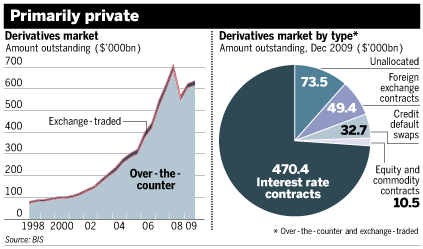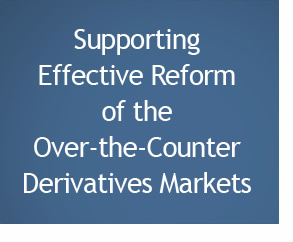08/11/10 - Financial Times - By Aline van Duyn
|
|
Financial markets: Derivative dilemmas
Ari Bergmann is putting the finishing touches to a course he will begin teaching at New York University in a few weeks. Yet, in spite of his best efforts, much of the curriculum cannot yet be written. That is because of a big battle that is about to explode, on Wall Street and in the deepest bowels of Washington.
Mr Bergmann will teach people ranging from investors to corporate treasurers how to spot financial risks and how to manage them. The tools used to do this are derivatives, which he first traded in the 1980s – contracts whose value is linked to a financial instrument, from the rate of interest paid on US government bonds to the price of oil.
The derivatives market is one of the biggest in the world. At the end of last year, contracts with a face value of $636,431bn were swirling around the world’s financial system, according to the Bank of International Settlements. Just 3.4 per cent of the total were traded on exchanges. The rest – $614,674bn worth, equivalent to nearly 10 years of global economic output – were agreed and traded in private markets, under terms struck directly between the buyers and sellers.
Over the next year, an entirely new rulebook is to be drawn up for this privately traded part of the financial markets, also called over-the-counter (OTC) derivatives. President Barack Obama’s signature on the Dodd-Frank Wall Street Reform and Consumer Protection Act on July 21 started the countdown. The legislation covers many parts of the financial system. Title seven – the part that deals with derivatives – is “among the most far-reaching and controversial sets of statutory changes” included in the new laws, according to lawyers at Cadwalader, Wickersham & Taft.
But whereas in theory the business is about to be revolutionised, in reality any changes will be preceded by bitter haggling over precisely what the rules prescribe – and proscribe. Crucially for banks, investors and the future health of world economies, just how far-reaching the outcome will be depends in large part on the decisions made by the two Washington regulators who will police a market that grew dramatically in recent decades without direct oversight.
The two – the Securities and Exchange Commission (SEC) and the Commodity Futures Trading Commission (CFTC) – have increased their staff numbers in anticipation of the rule-writing and their huge extra enforcement duties. For the most part, the rules have to be written by July 2011. These are regulators that usually write just a handful of new rules every year but, thanks to the new legislation, there will be more than 100 definitions and rules to get through. “Many of the key terms in the derivatives legislation are either undefined or are left for the regulators to fill in,” says Cadwalader.
The root cause of the financial crisis involved losses on risky US mortgages. The entire global financial system was exposed to these mortgages after hundreds of billions of dollars of complex securities linked to them were sold to investors from Illinois to Iceland. Derivatives were the building blocks for those securities.
The degree to which derivatives had created a dangerously interconnected financial system became clear amid the collapse of Bear Stearns, Lehman Brothers and AIG in 2008. A default by one bank at the centre of a tangled web of derivatives contracts could paralyse the entire financial system, because the derivatives could become worthless if the bank writing the contract went under.
“In the wake of the recent financial crisis, over-the-counter derivatives have been blamed for increasing systemic risk,” said Federal Reserve Bank of New York staff in a paper earlier this year. “OTC derivatives serve a vital role in financial markets but deficiencies in the market design and infrastructure allowed for misuse of these instruments, exacerbating the recent financial meltdown.”
Regulators have swept in to restore confidence in markets before. After the crash of 1929, the SEC was set up to police the equity markets and create structures that would reassure investors the cards were not stacked against them. The CFTC, with its roots in commodity markets, has done the same for exchange-traded futures. Now, the regulators will try to do the same for derivatives markets.

“The Wall Street reform bill will for the first time bring comprehensive regulation to the over-the-counter derivatives marketplace,” says Gary Gensler, chairman of the CFTC. The new rules will “lower risk, promote transparency and protect the American public”, he adds.
Under the new regulations, the derivatives world will be divided in two. On one side will be those products that are widely used, simple in structure and actively traded: standardised derivatives. Those will be pushed on to clearing houses to make the financial system less vulnerable to the default of a big derivatives dealer.
Clearing houses can reduce counterparty and systemic risks by standing in the middle of trades – though there of course remains a risk the clearing house itself may fail. The clearing house has a pool of capital and collects collateral and margin – up-front payments against possible losses. If these resources are not enough to cover a default by a member, the others are supposed to cough up.
Cleared derivatives will also have to be traded on electronic systems – although exactly how those systems will be defined, and how quickly and frequently price information has to be made public remains to be resolved. Mr Bergmann, who advises investors on derivatives strategies, says public pricing would reduce the chances that buyers – such as municipalities or small pension funds – would overpay. Customers who pay banks too much would soon know if the value is lower than they thought. If the contracts are centrally cleared, they would have to come up with an extra margin to pay the clearing house as soon as the price falls. “Mispricing of derivatives has often not been discovered until it is a disaster,” says Mr Bergmann. “In theory, with widespread clearing people will know about it before it becomes a disaster.”
Once regulators determine what part of the OTC derivatives or swaps markets has to be cleared, the remaining part will also be policed. No one knows what proportion will be uncleared, or what the targets are, although for all derivatives the more heavily regulated exchange-traded futures market provides the likely standard. “Look at the way futures have traded on exchanges,” says Viral Acharya, professor of finance at NYU’s Stern business school. “Similar practices, in one way or another, will be applied to OTC derivatives under new regulations. There will be more capital required, less leverage and less opacity.”
How regulators decide the clearing houses should hold the collateral against trades, and the extent to which derivatives users can offset positions against each other, will also be key. Banks have built huge internal clearing systems in recent decades, divisions usually called “prime brokerage”. Through these, big institutional investors or hedge funds can buy and sell all kinds of financial instruments – from bonds to credit derivatives to currency swaps to commodity investments – and offset them against one other. If an investor has to pay for each part of the trade – usually called a “leg” – having to hand over cash for each piece could add up. If the positions are offset, the trade can be done much more cheaply.
“We still don’t know what kinds of trades will be profitable or which of our customers will have to change their investment strategies,” says the head of prime brokerage at one big bank.
These questions about the costs also mean that the risks of the clearing houses and the business model behind them cannot be properly worked out – leaving investors in limbo. “When we use a clearing house, we have to be able to make a case as to why we think they are financially sound,” says the head of trading at one of the biggest institutional investors. “We cannot determine this until we know what the new rules will be.”
There is a lot to play for. According to Tabb Group, the biggest derivatives dealers generate revenues of $40bn a year from the OTC business.
As the rules are rewritten there will be much behind-the-scenes jostling as current derivatives big-shots – which include all the Wall Street banks – try to hang on to market share and newcomers try to muscle in. “This is a big business opportunity,” says Larry Tabb, chief executive of Tabb Group.
The cast of characters embraces not only big banks such as Goldman Sachs, JPMorgan Chase, Morgan Stanley, Barclays Capital and Deutsche Bank but exchanges such as CME Group, Nasdaq OMX, NYSE Euronext and Intercontinental Exchange, which want clearing business. It also includes smaller banks and brokers that are trying to expand their derivatives business, for instance Nomura and Jefferies, as well as inter-dealer brokers including Icap, and other financial groups that want to get into clearing or trading, from Tradeweb to State Street to tiny start-up brokerage firms.
The outcomes will affect investors, banks and companies that use derivatives extensively for hedging. The end result will also depend on what happens in Europe. “A lot of these things won’t work well if one centre applies rules that are not as strict,” says Mr Arachya.
With the answers to the questions about the future shape of the derivatives markets now in the hands of staff and commissioners at the regulators, the CFTC’s Mr Gensler says CFTC and SEC teams have already met five or six times since the legislation was passed. A series of public hearings is expected to be held from September onwards.
The potential for turf wars is of concern, as is the possibility of disruption to investment and trading activities. “The enormity of the proposed changes could result in both short-term pain for users of swaps and participants in the derivatives markets generally, and long-term unintended and undesirable changes in the marketplace,” say lawyers at Jones Day. “The extent to which the rulemaking process will provide the necessary clarity will depend in part on how well the CFTC and SEC are able to work together in areas of potentially overlapping jurisdictions.”
Whatever the case, the coming months will determine what is ultimately discussed in Mr Bergmann’s course about risks and markets. Not for nothing is the biggest section in his course outline entitled: “Derivatives: weapons of mass destruction or weapons of mass protection?”
|



